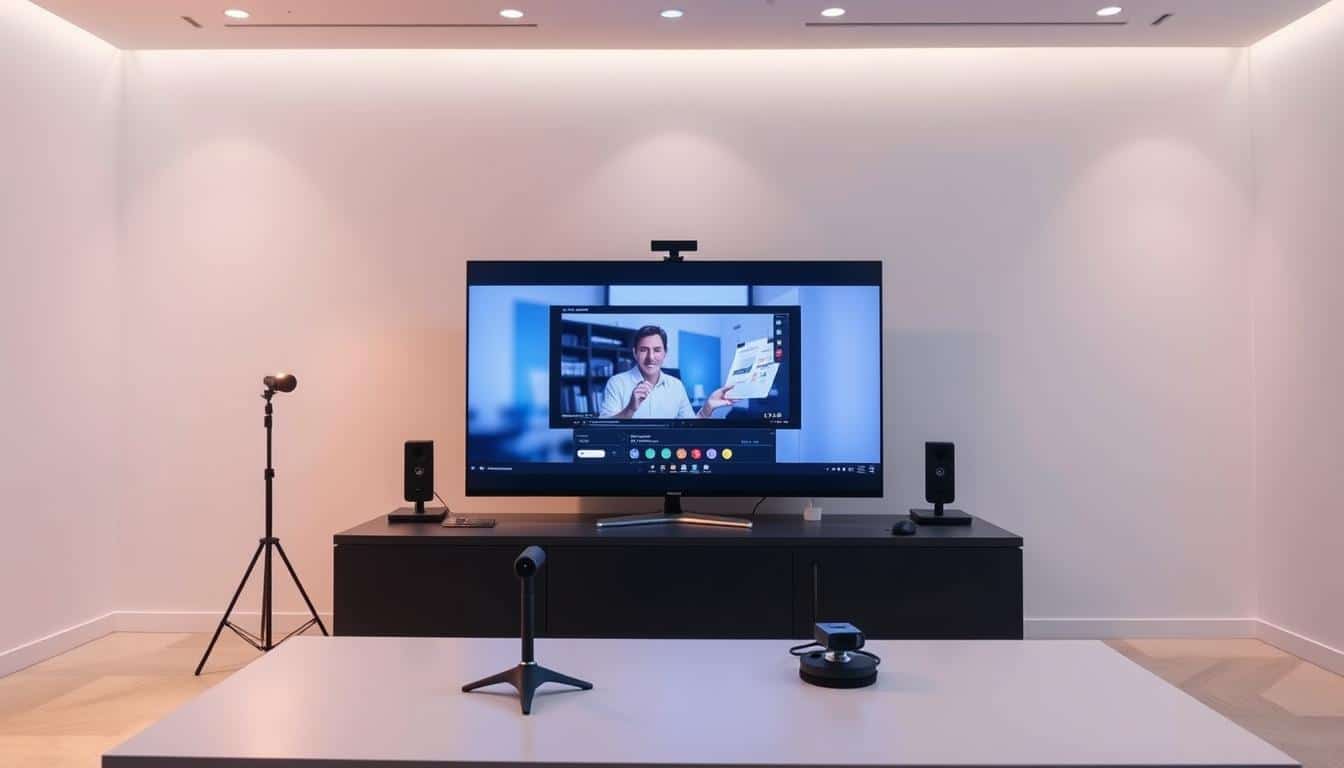The rise of remote meetings has changed how we communicate in 2023. Effective setup is now crucial for success, whether in business or education. This guide highlights what you need for productive online meetings.
Technology keeps evolving, and with the right tools, we can connect better across distances. This leads to more meaningful online interactions.
Anúncios
We’ll look at how setting clear goals and agendas helps keep meetings on track. Using active moderation and tools like polls makes meetings more effective. It’s also vital to manage time well to ensure productivity.
Dealing with tech problems and communication issues can be tough. But we’ll provide tips to overcome these, improving your virtual meeting setup.
Understanding Virtual Meetings
Virtual meetings are a cool way for people in different places to meet online. They use the internet to create a space where everyone can join in. These meetings can be for work, hanging out, or even getting therapy. They’re different from meeting up in person because anyone, anywhere, can join if they have internet.
There are several kinds of virtual meetings. What kind you choose depends on what you need it for. Video conferences let you see who you’re talking to. Web conferencing and webinars are great for working together or sharing info. For just talking, teleconferencing works because it’s audio-only. Knowing the differences helps choose the best type for your needs.
Why Virtual Meetings Are Essential in 2023
Remote work’s popularity is rising, making virtual meetings very important. They do more than just save time; they help teams work better together, even in mixed work settings. Being able to meet without worrying about where everyone is makes a big difference for companies and their workers.
Benefits for Remote Work and Collaboration
Virtual meetings make working together from different places easy. They let people work together well, no matter where they are. The benefits include:
- They save money on travel, which helps businesses use their money better.
- Workers can join from anywhere, fitting all kinds of work habits.
- Features like instant translation and noise reduction make discussions better.
- Meeting recordings and notes help keep track of what was said and done.
- A happier workforce, as 77% feel more satisfied with their jobs when they can work remotely.
Statistical Trends in Virtual Meeting Usage
The move towards more virtual meetings is clear from the stats. They show a big change in how we talk at work:
- In 2022, 75% of medium-sized companies chose a hybrid work style, blending office and remote work.
- By 2025, half of all company online events will happen on video platforms employees use every day.
- Virtual meetings can make teams more focused by cutting down on travel time.
- They also help the planet by reducing travel, which means less pollution.
Tools Required for Effective Virtual Meetings
To hold an efficient online meeting, you need the right tech gear and software. Knowing which hardware to use and picking the best video chat software can make your online talks much better. Let’s look at what you need for great virtual meetings.
Necessary Hardware: PCs, Cameras, and Microphones
For smooth virtual meetings, you should have good PCs, laptops, or smartphones. They must have working cameras and mics. These are basic but crucial for any video call. A solid internet connection is also key to keep the video quality up. This means you need fast and stable internet. There are options to join calls on phones or even without video, which adds flexibility.
Software Options: Video Conferencing Platforms
There are many choices for video call apps to fit different team needs. Popular ones like Zoom and Skype offer good sound and picture. They also let you share your screen and link with tools like Google Calendar. For teams not in the same time zone, Loom is great for recording and sharing videos. Krisp cuts down on background noise, and Camo lets your phone be a high-quality camera.
Organizing meetings gets easier with Calendly because it picks times for you, which helps avoid mix-ups. Otter.ai can take notes for you by transcribing your meetings, so you can pay more attention to talking. Digital Samba is another good choice with HD streaming, sharing files, and tools for working together better during calls.
Virtual Meeting Setup Essentials
Creating a good virtual meeting space is key for working well together. You should start by picking the right tools. This improves how we talk and get things done together. By checking out different platforms and making sure they’re set up right, meetings will run smoother.
Choosing the Right Meeting Platform
When picking a platform for meetings, consider what users like, device support, cost, and the features it offers. There are a lot of options like Zoom, Microsoft Teams, and Google Meet. Each one meets different requirements. Zoom is easy to use and has many features. Microsoft Teams is great for teamwork. Google Meet is perfect for both small and big meetings.
Configuring Audio and Video Settings
For better audio, use good mics to cut down on background noise and be clearer. Always test your audio before meetings to avoid any problems. In terms of video, asking people to use conference cameras makes everything look better and more professional. It’s also important for everyone to know how to mute and unmute. This makes meetings run better.
Types of Virtual Meeting Formats
Knowing the different types of virtual meetings is key today. They help a lot with talking and working together online. You can choose the right one for small team talks or big training talks. Let’s look at video conferencing and webinars because they are important and work differently.
Video Conferencing
Video conferencing lets people talk like they’re together, no matter where they are. It’s great for keeping teams connected and makes sure everyone gets seen. You can share your screen and use virtual backgrounds to look good and work well together.
This way of meeting can have up to 250 people, perfect for big groups. If you need to talk in smaller groups, you can use breakout rooms. This makes discussions more pointed and helpful.
Webinars and Their Uses
Webinars are mainly for sending info one way to an audience. They’re good for training, showing new products, and giving out information. They can hold a lot of people and let attendees ask questions during Q&A parts.
But, it’s tricky to keep everyone engaged and answer every question. Using webinars well can help a lot with getting new contacts and spreading the word about what you do.
Advantages of Employing Virtual Meetings
The shift to virtual meetings has brought key benefits for businesses and teams. These go beyond simple conveniences. They change how we work together completely.
Cost and Time Efficiency
Virtual meetings cut costs tied to travel, accommodations, and venues. Businesses can use these savings in better ways. These meetings also save a lot of time. They let people join in from anywhere.
This means people from different time zones can work together without trouble.
Improved Collaboration and Productivity
Video conferencing tools offer ways to share screens and give feedback in real time. These help make meetings more productive. Decisions are made faster and discussions are livelier.
By removing distance issues, these meetings include more people easily. This helps with work-life balance and managing time better.
Challenges of Virtual Meetings
Virtual meetings come with their own set of hurdles. Often, tech issues can block the flow of a meeting. Problems like weak internet can interrupt talks, making everyone upset. Plus, when software doesn’t work right, it can delay everything even more.
Technical Difficulties: Internet and Software Issues
Tech problems, especially with the internet and software, can really disrupt virtual meetings. Participants may face unwanted breaks that take their focus away. It’s smart to check all gear before the meeting starts. Having a backup plan, like a phone-in option, is also a good idea. Noise around you can also distract; things like Krisp can help clear up sound.
Less Personal Interaction and Engagement
Virtual meetings miss out on personal connections, making it hard to keep everyone engaged. People can feel lonely even with top tech. It’s tough to match the casual chats of in-person meetings online. Keeping folks engaged is key. Adding things like polls and Q&A helps keep attention. Without clear goals and a set agenda, it’s easy to get off track and waste time.
Key Features for a Successful Virtual Meeting Platform
Choosing the right virtual meeting platform is critical. It must have features that support clear communication and teamwork. Important features include screen sharing and the option to record meetings.
Screen Sharing and Collaboration Tools
Screen sharing is key in virtual meetings. It lets users show their screens to others, making working together easy. High-quality video and audio are needed for sharing screens without issues.
Platforms like Zoom and Microsoft Teams are great for this. They offer cool tools like whiteboarding and breakout rooms. These help teams work better together. Plus, you can share files right in the meeting, so everyone stays on the same page.
Recording and Transcription Capabilities
Being able to record meetings is super helpful. It lets people who missed the live meeting catch up. Platforms like Cisco Webex and GoTo Meeting have this feature. They also offer transcriptions, making it easy to review what was discussed.
These features make sure important info is noted accurately. With options to link with Google Drive and Office 365, finding meeting notes later is a breeze.

Essential Tips for Running Effective Virtual Meetings
For virtual meetings to be fruitful and engaging, using specific strategies is key. These include making a good agenda, setting a welcoming tone, and making sure everyone gets to participate. Follow these essential tips to make your virtual meetings better.
Creating an Agenda for Clarity
Keeping meetings on track needs a clear agenda. Think about these points when making your agenda:
- Define clear objectives for the meeting.
- Specify the topics to be covered along with estimated timeframes for each item.
- Review action items at the end, including responsible parties and due dates.
- Send out the agenda with the meeting invitation to help participants prepare in advance.
Also, inviting folks to log in early and check their tech improves meeting success.
Engagement Strategies for Participants
Try different ways to keep people involved and the discussion interesting:
- Introduce everyone at the start to create a welcoming atmosphere.
- Encourage active involvement by calling on participants by name.
- Implement techniques like Round Robin, ensuring that all attendees have a chance to speak.
- Use interactive polling to make the meeting more dynamic.
- Turn on video to facilitate connection and empathy among participants.
After meetings, ask for feedback. This helps improve future sessions, making engagement strategies better over time.
Preparing for a Virtual Meeting
The success of a virtual meeting greatly depends on thorough preparation. Making sure all technology works well is very important. This means checking your tech setup, like the webcam, microphone, and software before the meeting begins. Knowing the meeting details and reviewing the agenda effectively can also help everyone participate more and stay engaged.
Checking Technology and Background Setup
Before your meeting, do these things to improve your tech setup:
- Test your webcam, microphone, and internet connection to ensure clarity and reliability.
- Choose a quiet, well-lit location that minimizes distractions and background noise.
- Organize your workspace by closing unnecessary tabs and applications on your device.
- Ensure you have adequate bandwidth for smooth screen sharing and collaboration.
Reviewing Meeting Details and Agenda
To engage effectively during virtual meetings, good agenda review and preparation matter. Keep these tips in mind:
- Read any pre-meeting materials to familiarize yourself with topics.
- Conduct an agenda ahead of time so participants understand key discussion points.
- Schedule meetings at least one day in advance, allowing all attendees to prepare.
- Communicate specific requirements beforehand, such as camera usage and screen-sharing needs.
Best Practices for Virtual Meeting Etiquette
Being professional in virtual meetings helps you communicate and work together better. With the right virtual meeting etiquette, everyone’s experience improves. Look and act professional, keep your space tidy, and speak clearly. This makes the meeting better for all.
Professional Appearance and Environment
Wearing the right clothes for a virtual meeting shows you’re serious. It’s like you’re really there with them, showing respect. A neat workspace shows you’re focused. Good light and the camera at eye level make you seem more present and friendly.
Muting and Timing Best Practices
Listening and not interrupting is key in virtual meetings. Muting your mic when not speaking reduces unwanted noise. It shows you care. Be on time to respect everyone’s schedule, and use the hand-raise feature to speak. This keeps the meeting orderly.
Conclusion
In this summary of virtual meetings, we look at why setting up meetings well is key in today’s mixed work scene. It’s noted that 27% of U.S. workers are in a hybrid situation, and 11% are fully remote. So, making strong plans for online meetings is crucial. It helps people work together better and stay productive. Tools like Zoom, Google Meet, and Microsoft Teams can make meetings more engaging. This is done using methods like the PrePARE framework.
This recap shows that good virtual meetings need clear plans, a person in charge, and checking tech before starting. Adding fun starters and team activities keeps everyone interested, even online. Making sure there are tasks to do afterwards keeps the team on track. This makes the meeting’s effects last longer.
As online events become more common in work, it’s important to keep improving how we meet. Virtual meetings save money, are better for the environment, and are easier to join. Focusing on getting ready and doing things right helps teams work better together online. This is vital for dealing with changes in how we collaborate digitally.
FAQ
What are virtual meetings?
What types of virtual meeting formats are available?
Why are virtual meetings important in remote work?
What hardware is necessary for effective virtual meetings?
What software tools are recommended for virtual meetings?
How can I choose the right platform for virtual meetings?
What are some common technical difficulties faced during virtual meetings?
How can I create an effective agenda for my virtual meeting?
What are engagement strategies to keep participants involved during virtual meetings?
What etiquette should participants follow during virtual meetings?
Conteúdo criado com auxílio de Inteligência Artificial



